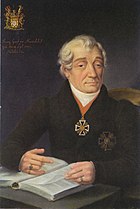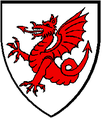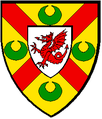Kesselstatt (noble family)
The von Kesselstatt are an old noble family that originally came from today's Hessian area and whose parent company of the same name was near Kesselstadt . Its members were in responsible positions in the service of church and state as prelates, abbots, diplomats, high officials and the military.
history
The family first appeared in documents in 1229 with a Hartwig von Plumheim , son of Ulrich von Kezzelstadt , who gave the Mainz canon Heinrich von Ravensberg a place and a mansus in Omestad Minoris . In 1297 a Mulich and Peter von Kesselstatt are mentioned as guarantors of Count Ludwig von Rieneck . A Rudolf von Kesselstatt is documented in 1340 as Vogt of Hanau . With Johann von Kesselstatt , who is mentioned in documents in 1365, the official line of the family begins .
In the 14th century the Knights of Kesselstatt came to the Electorate of Trier , initially as captains of the castle at the episcopal Montabaur Castle . The family settled on the Moselle and in Kurtrier through further offices and marriages:
- In 1384 Johann Moir von Kesselstatt was given the court office as an electoral trier marshal and received a high school in Koblenz.
- In 1385 Friedrich von Kesselstatt, who had already held offices for Elector Kuno II von Falkenstein , a. a. with a wine interest from the electoral tax to Karden / Mosel and the Klotten Castle .
- In 1404 Friedrich's brother Dietrich received the post of bailiff in Daun from Trier Elector Werner von Falkenstein .
- In 1423 Dietrich was enfeoffed with the castle house in Kröv / Mosel and appointed as administrator of the Electoral Trier rights in the Kröver Empire ; The family held the office of Obervogte with a few interruptions until the end of the electoral state in 1794.
- Friedrich II., Son of Friedrich I († 1473), lord of the castle of Klotten, married von Geza von Daun a third of the Kondelwald .
- In 1445 Friedrich I and his son Friedrich II acquired the lordship and castle in Föhren from the brothers Alf and Kuno von Bassenheim, which had already been pledged in 1428 . Kuno von Bassenheim was married to Katharina von Kesselstatt, Friedrich II's sister, which resulted in family ties between buyer and seller. Föhren Castle has been the seat of the Imperial Counts of Kesselstatt since then .
- In 1690 Casimir Friedrich Freiherr von Kesselstatt married Anna Clara Freiin von Metternich -Burscheid and after the death of his father-in-law Wolfgang Heinrich Freiherr von Metternich-Burscheid inherited his lords, houses and fiefs, etc. in 1790. a. the manor house with the lordship of Lösnich , Haus und Herrschaft Bruch , the lordship of Dodenburg (which remained in the possession until 1952), the lordship of Bitburg , the Kriechinger Hof zu Kröv and the Metternich-Burscheider house in Koblenz. Associated with this was the office of treasurer in Kurmainz .
- With Peter von Kesselstatt as abbot of the Augustinian monastery in Springiersbach (from 1432 to 1468), the family had achieved an important church position for the first time. Peter was a brother of Friedrich II.
- In the 17th and 18th centuries the family managed to achieve leading positions in the cathedral chapter in Trier. The highest after the Archbishop of Trier official church as provost had Karl Kaspar held (1686-1723), Hugo Wolfgang (1743-1750) and Franz Ludwig (1774-1777).
- From 1795 to 1828 Johann Philipp Franz Trierer was cathedral dean.
- The office of archdeacon ( vicar general ) was held by Georg Wolfgang from 1624 to 1626 and Lothar Adolf from 1699 to 1712.
From 1709 to 1932, Bekond Castle was also part of the family property. In the years 1740 to 1746 Hugo von Kesselstatt had a stately palace built by the well-known Baroque master builder Johann Valentin Thoman opposite the Trier Liebfrauenkirche . This was almost completely destroyed in the Second World War, but was rebuilt as today's restaurant according to old plans.
According to a list by Franz Xaver Streitberger from 1802, the imperial count's house owned possessions and 1774 subjects in 35 places and also wineries and wine rents. Emperor Josef II elevated the barons of Kesselstatt to imperial counts in 1776 .
Föhren Castle, ancestral seat of the family from 1445 until today
Kesselstatt Palace in Trier
Manor house in Lösnich
"Reichsgraf von Kesselstatt" winery
With a history of over 650 years, the Reichsgraf von Kesselstatt winery is one of the most traditional goods in the Mosel-Saar-Ruwer growing region. In 1978 Günther Reh (majority owner of the Sektkellerei Schloss Wachenheim with the well-known house brand Faber Sekt ) acquired the Reichsgraf von Kesselstatt winery
coat of arms
The family coat of arms shows: “In silver, a two-legged winged red dragon with a snake-like abdomen and an upturned spiked tail. On the red and silver puffed helmet with red and silver blankets the growing red dragon. "
The coat of arms of the imperial counts of Kesselstatt (1776): "In gold, a red St. Andrew's cross († von Orsbeck), each angled by a green sea leaf, with the family coat of arms as a heart shield."
Föhren coat of arms , enfeoffed by Kesselstatt

people
- Edmund von Kesselstatt (1765-1840), German Roman Catholic clergyman
- Christoph von Kesselstatt (1757–1814), canon in Hildesheim, Paderborn and Münster, cathedral dean in Paderborn, collector of manuscripts and early prints
- Franz von Kesselstatt (1753–1841), German art collector and painter
- Franz von Kesselstatt (Canon, 1757) (1757–1814), German Roman Catholic clergyman and Canon
- Georg Wolfgang von Kesselstatt (1561–1637), Cathedral Chapter in Trier and Archdeacon in Dietkirchen
- Hugo von Kesselstatt (1727–1796), court master of the Trier elector and imperial privy councilor
- Hugo Wolfgang von Kesselstatt (1659–1738), provost of the cathedral in Mainz, canon in Halberstadt and Liège, and privy councilor of Trier
- Johann von Kesselstatt (1691–1730), provost in Trier
- Johann Philipp von Kesselstatt (1754–1828), cathedral capitular in Trier and archdeacon in Karden
- Joseph Franz von Kesselstatt (1695–1750), German baron, diplomat and canon
- Karl Kaspar von Kesselstatt (1652–1723), governor, rector of the university and president of the court council in Trier
- Lothar von Kesselstatt (1662–1712), cathedral provost in Trier and Speyer, archdeacon in Dietkirchen
literature
- Genealogical manual of the nobility , Adelslexikon Volume VI, Volume 91 of the complete series, CA Starke Verlag, Limburg (Lahn) 1987, ISSN 0435-2408
- Rudolf Reichsgraf von Kesselstatt, The Reichsgrafen von Kesselstadt . City time 7 - Kesselstadt - highlights on two millennia - 950 years of first mention of Kesselstadt; Hanau 2009; 286-293; ISBN 978-3-937774-73-2
Web links
- Literature about Kesselstatt in the catalog of the German National Library
- The Imperial Counts of Kesselstatt. Dr. Richard Laufner, historical portrait of an old family in the Trier region
- www.kesselstatt.com Website of the Reichsgraf von Kesselstatt winery
- www.schloss-foehren.de Website Schloss Föhren, ancestral seat of the imperial counts of Kesselstatt
- Palais Kesselstatt Trier , Schloss Bekond , castle pines Dr. Bernhard Peter, heraldry and coat of arms
Individual evidence
-
↑ Ulrich von Kezzelstadt in Klein-Umstadt. Historical local dictionary for Hesse (as of January 13, 2011). In: Landesgeschichtliches Informationssystem Hessen (LAGIS). Hessian State Office for Historical Cultural Studies (HLGL), accessed on December 12, 2011 .
Note: Actually, the gender verification at LAGIS is incorrectly linked, as today it is largely proven that with omestad minor the place Wenigumstadt and not Klein-Umstadt is meant. Wenigumstadt is also in the area of the document exhibition - the Bachgau - Plumgau. Only later did the name change to a few omestat in Wenigumstadt . Klein-Umstadt, on the other hand, was referred to as unnestat in the 13th century and as omestad minor only from the beginning of the 14th century . The confusion is due to the introduction in the 19th century mistranslation of the corresponding Regesten because Latin minor into German fewer or smaller can be translated. In addition, both places are close to each other.
See also: Schopp, Manfred: "Small Umstadt in the History 1305-2005" , Ed. Magistrat der Stadt Groß-Umstadt, 2005, pp. 11-12
- ^ Riemer, document book on the history of the gentlemen of Hanau, Dept. II, I, No. 771
- ↑ Dr. Richard Laufner, Die Reichsgrafen von Kesselstatt, Yearbook District Trier 1969, pp. 137–147










